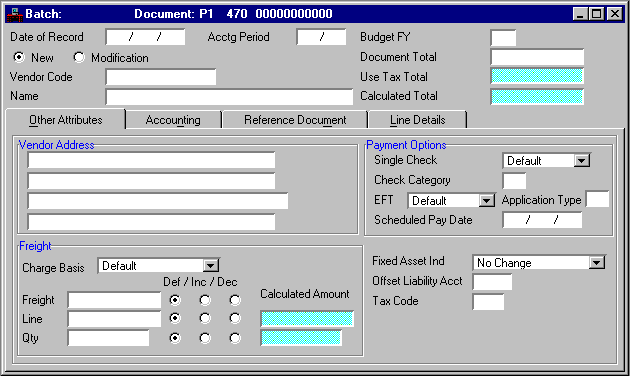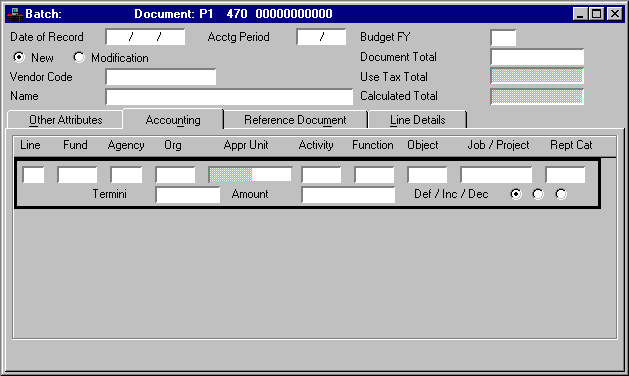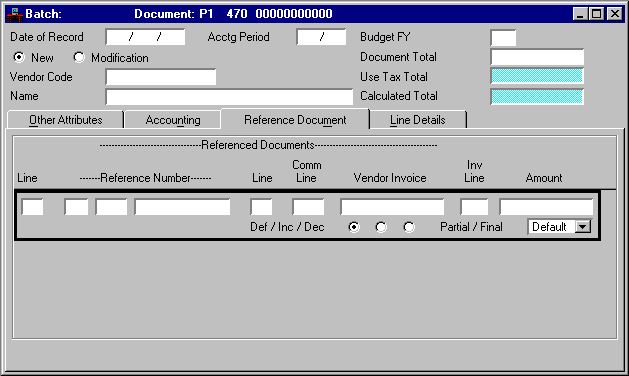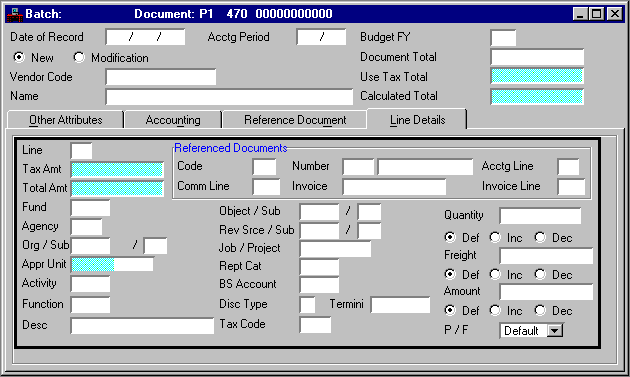|
|
|
|
Date of Record
|
Default is the date the document is accepted. Enter the date (
mm dd yy
) that you want to associate with these documents, usually the current date. You cannot enter a future date.
|
|
Acctg Period
|
Default is inferred from
Date of Record
. If you want these transactions recorded in another accounting period, enter the desired open period, using fiscal month and fiscal year. You cannot enter future periods.
|
|
Budget FY
|
Default is the current fiscal year. If you want these transactions recorded in another budget fiscal year, enter the desired open fiscal year. You cannot enter future budget fiscal years.
|
|
New/Modification [Action]
|
Default is
New [E]
. Valid values are:
New [E]
Indicates that this is a new entry (new document).
Modification [M]
This allows you to add lines to a previous document, change the amounts on existing lines (not codes), or cancel a line (decrease a line amount to zero). To change codes in an existing line, you must cancel that line and reenter a new line. You can record both these lines on the same document by entering
Modification [M]
.
|
|
Document Total
|
Required. Enter the net amount of all lines on the document, not including tax if the tax codes used on the document are for use tax. To compute this amount:
1. Add all the increase amounts.
2. Add all the decrease amounts.
3. Subtract the smaller of these amounts from the larger.
4. If the tax codes used are marked
U
(use tax) on Tax Code (TAXT), add together all the adjustment amounts on the lines (pay attention to signs) and subtract that amount from the result of #3.
5. Enter that amount.
|
|
Vendor Code
|
Conditional. Required if
Vendor/Commodity Control
on System Control Options (SOPT) is set to
Both Controls in Effect [Y]
). Leave blank on internal vouchers. Otherwise, it is optional. Enter the vendor you want paid as a result of this document. See Vendor Index (VEND) for valid values. Note:
Vendor Code
cannot be
Miscellaneous
if the
Object Code
is 1099 reportable.
|
|
Use Tax Total
|
The total amount of tax calculated for this document is displayed if the tax codes used on the document are Use Tax. This amount plus the document total must equal the calculated total.
|
|
Name
|
Default is inferred from Vendor (VEN2). Required on vouchers for outside vendors when
Vendor Code
is blank or if a miscellaneous vendor code is used. Enter the name you want printed on checks.
|
|
Calculated Total
|
This field contains the system-computed total of the line amounts is displayed.
|
|
|
|
Vendor Address
|
|
(no label)
|
Default is inferred from Vendor (VEN2). Required on vouchers for outside vendors when
Vendor Code
is blank or if a miscellaneous vendor code is used. Enter the address you want printed on checks.
|
Payment Options
|
|
Single Check
|
Defaults to
Default [blank]
. Only specify a choice here if a vendor elects to receive payments in a different manner than already specified on Vendor (VEN2).
Select
Yes [Y]
if you want a separate check printed specifically for this voucher. If
Default [blank]
is selected, the system adds this voucher's amounts together with other vouchers for the same vendor (by check category) to obtain a combined voucher check amount. On a modification transaction, select
No Change
.
|
|
Check Category
|
Optional. This field specifies the category that this check voucher is printed under. Vouchers are summed by vendor and check category. See Check Category (CCAT) for valid values.
|
|
EFT
|
Defaults to
Default [blank]
. Required if you want the current payment voucher paid by Electronic Funds Transfer (EFT). Valid selections are
Default [blank]
,
No Change [blank]
,
Yes [Y]
, or
No [N]
. Enter
Yes [Y]
in this field and enter a valid application type to select this voucher for electronic funds payment. When blank, this field defaults to
No [N]
, unless the vendor is eligible for electronic fund transfer.
A vendor is eligible for Electronic Funds Transfer (EFT) when
EFT Status
on Vendor (VEN2) is
Active [A]
.
If
EPPV Requirements
on EPS System Control Options (ESOP) is
Yes [Y]
, and the vendor is eligible for electronic funds transfer, this field is inferred from the referenced Vendor Invoice (VI) as long as
EFT
is set to
Yes [Y]
on all of the invoices referencing this payment voucher. If
EFT
is not set to
Yes [Y]
on any of the related Vendor Invoice (VI) documents or one or more payment voucher lines do not reference Vendor Invoice (VI) documents, you must manually set
EFT
to
Yes [Y]
on this document. If the vendor is eligible for electronic funds transfer and
EFT
is
Default [blank]
or there are no referenced Vendor Invoice (VI) documents,
EFT
defaults to
Yes [Y]
in the document header. When entering internal vouchers, select
Default [blank]
in this field.
|
|
Application Type
|
Conditional. Required if
EFT
is set to
Yes [Y]
; otherwise, do not enter this field. The application type is a two-character code representing the intended application, or use, of the funds being electronically transferred. See Electronic Funds Transfer Application Type (EFTA) for valid values.
If
EPPV Requirements
on EPS System Control Options (ESOP) is
Yes [Y]
the following description also applies. When blank and
EFT
is set to
Yes [Y]
, the application type is automatically taken from the referenced Vendor Invoice (VI), as long as the application types on all of the Vendor Invoice (VI) documents referenced on this payment voucher are the same.
If
EFT
is set to
Yes [Y]
and there are no Vendor Invoice (VI) documents to take the application type from, the application type is automatically taken from
EFT Type
on Vendor (VEN2), if one exists. Otherwise, the user must supply this field.
|
|
Scheduled Pay Date
|
Default automatically assigns a date according to the following rules:
If
Scheduled Payment Day
is entered on Vendor (VEN2) for this document's vendor, that value is used. The payment day is the day of the month when you want to pay this vendor. The system assigns the payment date using this day and the current month, or, if the resulting date has already passed, the next month.
System Payment Lag
on System Control Options (SOP2) is used as the default if
Scheduled Payment Day
is blank on Vendor (VEN2). The payment lag is the number of days from the voucher date when you want to issue payment.
If both
Scheduled Payment Day
on Vendor (VEN2) and
System Payment Lag
on System Control Options (SOP2) are blank, then the system date is used.
Applies only to vouchers for outside vendors. Enter the date when you want the check for this payment voucher issued, if you want to override the system computed date.
-
You can change scheduled payment dates on modifying transactions or through Payment Voucher Scheduling (SCHD). For further details, see the
User's Guide
.
|
Freight
|
|
Charge Basis
|
Defaults to
Default [blank]
. To use this field, you must install the Extended Purchasing Subsystem (EPS) and turn linking on. This field indicates whether or not freight charges factor into the total cost of this commodity and what method is used to calculate those charges. Valid values are:
Default [blank]
If this document references another document with a freight indicator value, this field is set to
By Commodity [C]
. Otherwise, freight is not included on this document.
By Quantity [Q]
Prorate the freight total for the current document across all commodity lines by quantity.
By Line [D]
Prorate the freight total for the current document across all commodity lines by pre-tax-amount.
By Commodity [C]
Allow users the option of entering freight on individual commodity lines.
No Freight Allowed [N]
Do not include freight on this document. Freight is not inferred if another document is referenced.
No Change [blank]
|
|
Freight (Amount)
|
If
Charge Basis
is
By Commodity [C],
the freight total for the document is supplied by the system when this field is blank.
If
Charge Basis
is
By Quantity [Q]
or
By Line [D]
, this amount is required. If a value is entered, regardless of the value in
Charge Basis
, it must equal the sum of all commodity line freight amounts.
|
|
Freight
(Def/Inc/Dec)
|
Defaults to
Default [blank]
. Required when modifying
Freight Amount
; select
Default [blank]
or
Increase [I]
during a new entry; select
Default [blank]
when
Freight Amount
is blank.
|
|
Line (Amount)
|
Conditional. Required if
Charge Basis
is
By Line [D]
and leave blank if the freight indicator is any other value. Enter total cost of all commodity lines on this document before tax and freight, but after discounts are factored in.
|
|
Line
(Def/Inc/Dec)
|
Defaults to
Default [blank]
. Select
Increase [I]
or
Decrease [D]
if modifying
Line Amount
; select
Default [blank]
or
Increase [I]
during a new entry; and select
Default [blank]
when
Line Amount
is blank.
|
|
Line (Calculated Amount)
|
System calculated pre-tax, pre-freight, and post-discount total amount for the document is displayed. This amount is used to verify that
Line Amount
is correct and is only calculated if
Charge Basis
is
By Line [D].
|
|
Qty (Amount)
|
Conditional. Required if
Charge Basis
is
By Quantity [Q]
; leave blank if
Charge Basis
is any other value. Enter the total quantity for the document.
|
|
Qty
(Def/Inc/Dec)
|
Defaults to
Default [blank]
. Required when modifying
Quantity Amount
; select
Default [blank]
or
Increase [I]
during a new entry; select
Default [blank]
when
Quantity Amount
is blank.
|
|
Qty (Calculated Amount)
|
System calculated total quantity for the document is displayed. This quantity is used to verify that the user supplied total quantity is correct and is only calculated if
Charge Basis
is
By Quantity [Q].
|
|
Fixed Asset Ind
|
Default is
No Change [blank]
. Valid values are:
Create One Shell [F]
The system will create one Fixed Asset Acquisition (FA) document for each line on this document.
Create Multiple Shells [Q]
The system will create the quantity of Fixed Asset Acquisition (FA) documents specified in
Quantity
for each line on this document.
|
|
Offset Liability Acct
|
Default is the value entered in
Vouchers Payable
on System Special Accounts (SPEC). Enter the balance sheet account you want credited for the liability created by this voucher. See Balance Sheet Account Index (BACC) for valid values.
|
|
Tax Code
|
Conditional. To use this field, you must install the Extended Purchasing Subsystem (EPS) and turn linking on. Enter the tax rate used for this document. See Tax Code (TAXT) for valid values. This field is used to calculate tax on each line. If this field is left blank and all line tax codes are the same, the tax code is inferred but not displayed.
|
|
|
|
|
Line
|
Required. Enter a different number for each line on the document. Numbers
00
to
99
are valid. This is a key field on Open Payment Voucher Line Inquiry (OPVL). It uniquely identifies the line from all other lines on the voucher.
|
|
Fund
|
Required. Default is inferred from Organization (ORG2) based on the agency and organization entered on this document. Otherwise, enter the fund paying for the item on this line. See Fund Index (FUND) for valid values.
|
|
Agency
|
Required. Enter the agency paying for the item on this line. See Agency Index (AGCY) and Fund Agency Index (FAGY) for valid values.
|
|
Org
|
Conditional. Required if
Expense Budget Organization Option
on Fund Agency Index (FAGY) is
Y
(required on budget and accounting) or
A
(required on accounting). Optional on balance sheet transactions. Enter the organization paying for the items listed on this line. See Organization Index (ORGN) for valid values.
|
|
Appr Unit
|
Required. Enter the Program Budget Unit element for the items listed on this voucher. See Program Reference Table (PRFT) for valid values. The Appropriation Program element and Allotment Program element will be inferred from PRFT based on Program Budget Unit.
|
|
Activity
|
Conditional. Default is inferred from Organization (ORG2), if it is included there. Otherwise, enter an activity if
Expense Budget Activity Option
is
Y
(required on budget and accounting) or
A
(required on accounting) on Fund Agency Index (FAGY). See Activity Index (ACTV) for valid values.
|
|
Function
|
Conditional. Default is inferred from Organization (ORG2); or from Activity (ACT2), if a function is not entered in Organization (ORG2). Otherwise, enter a function if
Expense Budget Function Option
is
Y
(required on budget and accounting) or
A
(required on accounting) on Fund Agency Index (FAGY). See Function (FUNC) for valid values.
|
|
Object
|
Conditional. For transactions that require a balance sheet account code, this field is optional. Enter the object that best describes the item named on this line. See Object Index (OBJT) for valid values. Note: If the object code entered is a 1099 reportable code, the
Vendor Code
cannot be
Miscellaneous
.
|
|
Job / Project
|
Conditional. Organizations and activities can be defined to require the entry of a job number. Refer to Organization (ORG2) or Activity (ACT2) for details.
Otherwise, this field is optional. If
Job Cost
is
Yes [Y]
on System Control Options (SOP2), enter a job number. See Job Index (JOBT) for valid values. If
Job Cost
is
No [N]
on System Control Options (SOP2), enter a project number or general reporting category.
|
|
Rept Cat
|
Conditional. This field is required on expenditure transactions if
Reporting Category
on Agency (AGC2) is
Required on Expenditure Transactions [3]
.
This field is required on revenue transactions if
Reporting Category Required on Revenue Transactions
is
Required [Y]
. For transactions that require a balance sheet account code, this field is required if
Reporting Category Option
is
Y
(required) on Balance Sheet Account Index (BACC). Otherwise, this field is optional. See Reporting Category (RPTG) for valid values.
|
|
Termini
|
Conditional. Required if Termini Validation Indicator is selected on Agency Project (AGPR) for this project. Enter the mile point, range of mile points, or bridge identifier at which work is performed for a given Highway Route. See Termini Reference Table (TERM) for valid values.
|
|
Amount
|
Conditional. Required if this payment voucher references an EPS purchase order and the purchase order has a warehouse code or
EPPV Requirements
on EPS System Control Options (ESOP) is selected
[Y]
. Otherwise, this field is optional. Enter the number of items paid for.
If modifying a previous document, enter the amount of change over (under) the previous amount. Do not enter a positive/negative sign; the increase/decrease indicator determines whether this is added to or subtracted from the original amount.
|
|
Def/Inc/Dec
|
Default is
Default [blank]
. Valid values on a new document are
Default [blank]
and
Increase [I]
. Valid values on a modification document are
Increase [I]
if
Amount
is increasing, or
Decrease [D]
if
Amount
is decreasing. If
Amount
is blank, select
Default [blank]
.
|
|
|
|
Referenced Documents
|
|
Reference Number
|
Conditional. Required if this line concerns items previously recorded on a requisition or purchase order; otherwise, it is blank. Enter the document code, agency and number of the document being referenced.
If a prior year purchase order is referenced, ensure that all values in the accounting distribution are valid for the prior year as well as for the current year.
|
|
Line
|
Conditional. Required if this line concerns items previously recorded on a purchase order; leave blank for requisitions. Enter the purchase order line number of the item being referenced.
|
|
Comm Line
|
Conditional. Required if
PV Update Inventory
on EPS System Control Options (ESOP) is selected [
Y
] and for payment vouchers referencing EPS purchase orders with a warehouse code.
Required if
Fixed Asset Indicator
is
Create One Shell [F]
or
Create Multiple Shells [Q]
on the payment voucher. Required if
Receiver Accrual
on EPS System Control Options (ESOP) is selected [
Y
]. Otherwise, this field is optional. Enter the commodity line number of the purchase order referenced.
|
|
Vendor Invoice
|
Optional. Enter the vendor invoice number, if one is available.
|
|
Inv Line
|
Conditional. Required if
EPPV Requirements
on EPS System Control Options (ESOP) is selected [
Y
] and a vendor invoice has been entered. Enter the line number of the referenced invoice.
|
|
|
|
|
Tax Amt
|
The amount of tax for this line is displayed. The system will calculate the tax amount using the amount supplied and the tax rate associated with the tax code applied to this line.
|
|
Total Amt
|
The total amount of this line is displayed. The system will calculate the total amount from the amount supplied and the calculated adjustment amount.
|
|
Sub-Org
|
Conditional. Required on expenditure transactions if
Sub-Organization Required on Spending
on Organization (ORG2) is
Required [Y]
or
Required on Expenditure Transactions [3]
.
Or, on vendor refund transactions if
Sub-Organization Required on Revenue
on Organization (ORG2) is
Required [Y]
. Otherwise, this field is optional. Enter the sub-organization paying for the items listed in this document. See Sub-Organization (SORG) for valid values.
|
|
Desc
|
Optional. Enter general descriptive information to be recorded with this transaction.
|
|
Sub-Object
|
Conditional. Required if
Object
is entered and
Sub-Object Required
is selected [
Y
] on Expense Budget Inquiry (Extended) (EEX2). Otherwise, optional. Enter the sub-object that best describes the item named on this line. See Sub-Object (SOBJ) for valid values. Note: If the object code entered is a 1099 reportable code, the
Vendor Code
cannot be
Miscellaneous
.
|
|
Rev Srce/Sub
|
Conditional.
Revenue Source
is required on vendor refunds. Enter the revenue source credited as a result of this document. See Revenue Source Index (RSRC) for valid values. If revenue source is entered,
Object
and
Balance Sheet Account
must be blank.
Enter a sub-revenue source if
Revenue Source
is entered and
Sub-Revenue Source Required
is
Yes [Y]
on Revenue Source (RSR2). If
Sub-Revenue Source Required
is
No [N]
, sub-revenue source is optional. See Sub-Revenue Source (SREV) for valid values.
|
|
BS Account
|
Default is inferred from Warehouse (WHS2) if this payment voucher references an EPS purchase order with a warehouse code. Enter this field only if this is an expense transaction. See Balance Sheet Account Index (BACC) for valid values. It cannot be any of the default accounts in System Special Accounts (SPEC). However, it can be the default fund balance account.
|
|
Disc Type
|
Optional. If a vendor discount policy applies to this voucher line, enter the appropriate discount type from Discount Type (DISC). A valid discount type must have
PO Discount Flag
set to
N
. The cash disbursement process determines whether the discount can actually be taken at the time the check is printed.
This field is blank on balance sheet transactions and vendor refunds.
|
|
Tax Code
|
Default is inferred by the system. Enter the tax rate to be used for this line. See Tax Code (TAXT) for valid values. This field can only be used when the Extended Purchasing Subsystem is installed with linking turned on.
|
|
Quantity
|
Conditional. Required if you are referencing EPS purchase orders that contain a warehouse code,
EPPV Requirements
is selected [
Y
] on EPS System Control Options (ESOP)
and
you are referencing an Extended Purchasing Subsystem purchase order, or
Fixed Asset Indicator
is
Create Multiple Shells [Q]
.
Otherwise, this field is optional. Enter the number of items paid for.
|
|
Def/Inc/Dec
|
Default is
Default [blank]
. Indicates whether the amount in
Quantity
is an
Increase [I]
or
Decrease [D]
.
Decrease [D]
is valid on a new document as long as
Discount Type
is blank and a requisition is not being referenced.
Decrease [D]
is used on new documents to record credit memos.
|
|
Freight
|
Default is inferred by the system. Leave blank if
Charge Basis
is any value other than
By Commodity [C]
. Optional if
Charge Basis
is
By Commodity [C]
; enter an amount in this field to include freight on this commodity line.
|
|
Def/Inc/Dec
|
Default is
Default [blank]
. Indicates whether the amount in
Freight
is an
Increase [I]
or
Decrease [D]
. This field can only be used when the Extended Purchasing Subsystem is installed with linking turned on.
|
|
P/F
|
Defaults to
Default [blank]
. This field is used only when a purchase order is referenced. Valid values are:
Default [blank]
This will leave this field blank.
Partial [P]
This value is optional (the system knows that the payment is partial because the payment voucher line amount is less than the purchase order line amount).
Final [F]
If the total amount expensed equals the purchase order line amount, then the purchase order line is closed automatically, and this value is optional. Select
Final [F]
if the total amount expensed is
less than
the purchase order amount, but you want to force a close (the item did not cost as much as expected) or if the total amount expensed is
more than
the purchase order amount (the item cost more than expected).
A maximum limit exists for how much the total amount expensed can exceed the purchase order amount. (
See discussion of purchase orders in the User's Guide
.)
|







